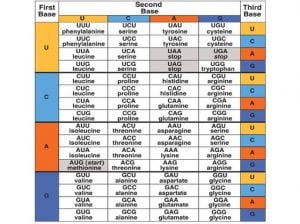- DNA contains a triplet code
- Every three bases on DNA stands for ONE amino acid
- Each three-letter unit on mRNA is called a codon
- Most amino acids have more than one codon!
- There are 20 amino acids with a possible 64 different triplets
- The code is nearly universal among living organisms
Important features of the genetic code include:
- Each codon consists of three bases (triplet). There are 64 codons. They are all written in the 5′ to 3′ direction.
- 61 codons code for amino acids. The other three (UAA, UGA, UAG) are stop codons (or nonsense codons) that terminate translation.
- There is one start codon (initiation codon), AUG, coding for methionine. Protein synthesis begins with methionine (Met) in eukaryotes, and formylmethionine (fmet) in prokaryotes.
- The code is unambiguous. Each codon specifies no more than one amino acid.
- The code is degenerate. More than one codon can specify a single amino acid.
- All amino acids, except Met and tryptophan (Trp), have more than one codon.
- For those amino acids having more than one codon, the first two bases in the codon are usually the same. The base in the third position often varies.
- The code is almost universal (the same in all organisms). Some minor exceptions to this occur in mitochondria and some organisms.
- The code is commaless (contiguous). There are no spacers or “commas” between codons on an mRNA.
- Neighboring codons on a message are non-overlapping.
